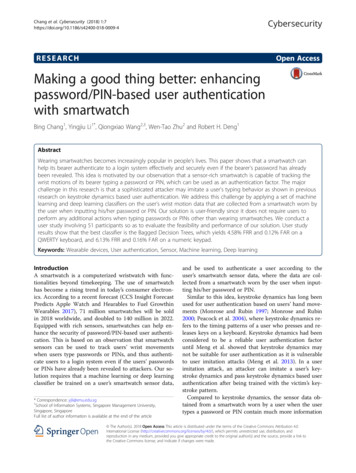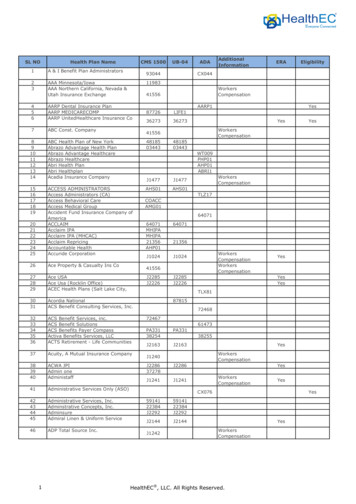
Transcription
CybersecurityChang et al. Cybersecurity (2018) CHOpen AccessMaking a good thing better: enhancingpassword/PIN-based user authenticationwith smartwatchBing Chang1, Yingjiu Li1*, Qiongxiao Wang2,3, Wen-Tao Zhu2 and Robert H. Deng1AbstractWearing smartwatches becomes increasingly popular in people’s lives. This paper shows that a smartwatch canhelp its bearer authenticate to a login system effectively and securely even if the bearer’s password has alreadybeen revealed. This idea is motivated by our observation that a sensor-rich smartwatch is capable of tracking thewrist motions of its bearer typing a password or PIN, which can be used as an authentication factor. The majorchallenge in this research is that a sophisticated attacker may imitate a user’s typing behavior as shown in previousresearch on keystroke dynamics based user authentication. We address this challenge by applying a set of machinelearning and deep learning classifiers on the user’s wrist motion data that are collected from a smartwatch worn bythe user when inputting his/her password or PIN. Our solution is user-friendly since it does not require users toperform any additional actions when typing passwords or PINs other than wearing smartwatches. We conduct auser study involving 51 participants so as to evaluate the feasibility and performance of our solution. User studyresults show that the best classifier is the Bagged Decision Trees, which yields 4.58% FRR and 0.12% FAR on aQWERTY keyboard, and 6.13% FRR and 0.16% FAR on a numeric keypad.Keywords: Wearable devices, User authentication, Sensor, Machine learning, Deep learningIntroductionA smartwatch is a computerized wristwatch with functionalities beyond timekeeping. The use of smartwatchhas become a rising trend in today’s consumer electronics. According to a recent forecast (CCS Insight ForecastPredicts Apple Watch and Hearables to Fuel GrowthinWearables 2017), 71 million smartwatches will be soldin 2018 worldwide, and doubled to 140 million in 2022.Equipped with rich sensors, smartwatches can help enhance the security of password/PIN-based user authentication. This is based on an observation that smartwatchsensors can be used to track users’ wrist movementswhen users type passwords or PINs, and thus authenticate users to a login system even if the users’ passwordsor PINs have already been revealed to attackers. Our solution requires that a machine learning or deep learningclassifier be trained on a user’s smartwatch sensor data,* Correspondence: yjli@smu.edu.sg1School of Information Systems, Singapore Management University,Singapore, SingaporeFull list of author information is available at the end of the articleand be used to authenticate a user according to theuser’s smartwatch sensor data, where the data are collected from a smartwatch worn by the user when inputting his/her password or PIN.Similar to this idea, keystroke dynamics has long beenused for user authentication based on users’ hand movements (Monrose and Rubin 1997; Monrose and Rubin2000; Peacock et al. 2004), where keystroke dynamics refers to the timing patterns of a user who presses and releases keys on a keyboard. Keystroke dynamics had beenconsidered to be a reliable user authentication factoruntil Meng et al. showed that keystroke dynamics maynot be suitable for user authentication as it is vulnerableto user imitation attacks (Meng et al. 2013). In a userimitation attack, an attacker can imitate a user’s keystroke dynamics and pass keystroke dynamics based userauthentication after being trained with the victim’s keystroke pattern.Compared to keystroke dynamics, the sensor data obtained from a smartwatch worn by a user when the usertypes a password or PIN contain much more information The Author(s). 2018 Open Access This article is distributed under the terms of the Creative Commons Attribution 4.0International License (http://creativecommons.org/licenses/by/4.0/), which permits unrestricted use, distribution, andreproduction in any medium, provided you give appropriate credit to the original author(s) and the source, provide a link tothe Creative Commons license, and indicate if changes were made.
Chang et al. Cybersecurity (2018) 1:7learning algorithms. (ii) A comprehensive performanceanalysis shows that our solution is secure against theimitation attack presented in (Meng et al. 2013). Even ifan attacker's keystroke timings are similar to a victim's,our solution can still differentiate imitators from legitimate users by analyzing smartwatch data. (iii) The presentation of this paper is improved with more details,analyses, and figures. Compared to the conference version, the length of this paper increases by about 50%.RoadmapThe rest of this paper is organized as follows. Section“Background” presents some background informationabout smartwatch, sensor dynamics, and keystroke dynamics. Section “Assumptions” introduces the assumptions thatare used in our solution. Section “Scheme Design” presentsthe details of our design. Section “Evaluation” evaluates oursolution. Section “Discussion” provides discussions on motion leaks and limitations. Section “Related Work” summarizes the related work, and Section “Conclusion” concludesthis paper.BackgroundSmartwatch and sensor dynamicsThere are various sensors on smartwatches to collect information about users, including accelerometer, gyroscope, heart rate sensor, and microphone. We chooseMoto 360 sport, which is powered by Android Wear OS,for our evaluation purpose. We collect data from accelerometer and gyroscope for the purpose of user authentication. The built-in motion sensor is an InvenSenseMPU 6051 Six-Axis (Gyroscope Accelerometer)MEMS motion tracking device, which can measure theaccelerations and angular velocities of movement in x-,y- and z-axis regardless of the orientation of watch. Accelerometer and gyroscope in smartwatches have been15acceleration (m/s2)about the user’s typing behavior, including accelerationand angular velocity data that are measured at a relativelyhigh frequency (e.g., 50 Hz). It is difficult for an attackerto imitate a victim’s wrist motions that are measured at ahigh frequency for password/PIN entry. We show that oursolution can effectively thwart the imitation attack tousers’ keystrokes.Interestingly, the sensor data measured by smartwatcheshave been exploited recently to conduct keystroke inferenceattacks (Liu et al. 2015; Maiti et al. 2016; Wang et al. 2016;Wang et al. 2015). While a user types on a QWERTY keyboard or numeric keypad, he/she moves his/her hand toreach the keys and this causes distinct motions of the user’swrist. The motion sensor data collected from the user’ssmartwatch can be used to track the user’s wrist motionsand thus infer the user’s inputs such as PINs and passwords. In common, previous studies on keystroke inferenceattacks show that the motion sensors of smartwatches canbe exploited to compromise user security and privacy.From another point of view, the motion sensor data collected from smartwatches contain unique features of users’typing behaviors, and can thus be exploited to enhance thesecurity of password/PIN-based user authentication.In this paper, we make good use of smartwatch sensordata to enhance password/PIN-based user authentication.Our solution is user-friendly since it does not require usersto perform any additional actions when typing passwordsor PINs other than wearing smartwatches. We show thatour solution is secure against the keystroke imitation attackproposed in (Meng et al. 2013). Even if an attacker obtainsa target user’s password and is able to imitate the keystrokedynamics of the user, our solution can detect the imitationattack with a high probability by analyzing the sensor datacollected from smartwatches. To evaluate the feasibility andperformance of our solution, we conduct an IRB-approveduser study with 51 participants. We test six popular machine learning algorithms for processing smartwatch data,and evaluate their performance in user authentication. Wediscover that the Bagged Decision Trees performs the bestin our user study, yielding 4.58% false reject rate (FRR) and0.12% false acceptance rate (FAR) on the QWERTY keyboard for password-based user authentication, and 6.13%FRR and 0.16% FAR on the numeric keypad for PIN-baseduser authentication.We also show that the keystroke imitation attack has insignificant impact on the accuracy of ourscheme.This paper extends a preliminary conference version"employing smartwatch for enhanced password authentication" published in WASA 2017 in the following aspects: (i) We apply a deep learning algorithm, longshort-term memory (LSTM) network to process smartwatch sensor data and evaluate its performance for userauthentication. We use TensorFlow to implement LSTMand compare its evaluation results with other machinePage 2 of 13105x axisy axisz axis0-5-101213141516time (s)Fig. 1 The accelerometer data when a user types “924673” followedby “Enter”
Chang et al. Cybersecurity (2018) 1:7Page 3 of 13angular velocity (rad/s)2x axisy axisz axis10-1-21213141516time (s)Fig. 2 The gyroscope data when a user types “924673” followedby “Enter”extensively used in user behavioral characterization, including sensor-based keystroke inference (Liu et al.2015; Maiti et al. 2016; Wang et al. 2016; Wang et al.2015). The basic idea is that the sensor data provide necessary information which can be used to accuratelyrecognize the hand movements performed by userswearing smartwatches. For instance, Figs. 1 and 2 showthe accelerometer and gyroscope data that we collectwhen a user types “924,673” using the keypad of DELLSK-8115 keyboard. These data contain the motion information when the user types the PIN. Instead of usingsuch sensor data for keystroke inference, we use themfor user authentication.Keystroke dynamicsKeystroke dynamics refers to the timing information associated with key-press events. Two types of key-pressevents are usually used in modeling keystroke dynamics, including (a) key-down event (KD): a user presses a key and(b) key-up event (KU): a user releases a key. One or morepossible keystroke timings associated with consecutivekey-press events, e.g., KD-KU time and KD-KD time, areconsidered as keystroke dynamics features in (KillourhyFig. 3 Keystroke timings used in keystroke dynamics techniquesand Maxion 2010) and shown in Fig. 3. Keystroke dynamicsfeatures have been used to identify and authenticate usersusing both hardware keyboards (Clarke et al. 2003; Karatzouni and Clarke 2007; Zahid et al. 2009) and software keyboards (Tasia et al. 2014; Trojahn and Ortmeier 2012).However, Meng et al. (2013) revealed that a training interface can be set up to help attackers imitate users’ keystrokedynamics, which makes it unsafe to employ keystroke dynamics for user authentication. Because keystroke dynamicscontains only the timing information about users’ keystroke, it is possible for an attacker to imitate a user’s keystroke via a training interface. To address this problem, wemodel a user’s typing behavior using both acceleration dataand angular velocity data from the user’s smartwatch. It isdifficult for an attacker to imitate a user’s typing behaviorin our model without accessing the victims’ smartwatchsensor data.AssumptionsIt is assumed that a user (the victim) wears a smartwatchsuch as Apple Watch or Moto 360 Sport, while he/shetypes passwords and PINs. The smartwatch is equippedwith accelerometer and gyroscope which collect the motioninformation of the victim’s wrist. If the victim uses onehand to type, the smartwatch is worn on the same hand. Assmartwatches are widely used, it is not uncommon to makesuch assumption in daily life. We focus on two types ofkeyboards in this paper, including QWERTY keyboards andnumeric keyboards, which can be used on PCs, mobile devices, Point of Sale (POS) terminals and Automatic TellerMachines (ATMs).An attacker intends to login to a user/victim’s accountafter the attacker obtains the victim’s username andpassword/PIN. The attacker may observe or record thevictim’s entry of passwords or PINs. However, it is assumed that the attacker cannot obtain any sensor dataabout the victim’s typing of passwords/PINs from thevictim’s smartwatch; instead, the attacker has the following capabilities. First, the attacker may obtain the victim’s username and password (e.g., by shoulder-surfingattack or key logger). Second, the attacker may obtainthe victim’s keystroke timing data and imitate the
Chang et al. Cybersecurity (2018) 1:7victim’s keystroke as shown in (Meng et al. 2013). Insuch imitation attacks, the attacker may wear the samekind of smartwatch and access the same kind of keyboard as the victim’s.Scheme designIn this section, we present the design of our smartwatchenhanced password/PIN authentication scheme.OverviewThe main goal of our design is to demonstrate that usingsmartwatches can help enhance the security of password/PIN authentication systems. Password/PIN authenticationsystems suffer from password/PIN observation attacks suchas shoulder surfing and key logging in which attackers mayobtain users’ passwords/PINs. We design and implement asystem which can distinguish legitimate users from illegitimate users by processing the sensor data from the smartwatches worn on legitimate users’ wrists. Even if anattacker types in the same password/PIN with the victim’s,the attacker’s hand motion is still different from the user’s.The accelerometer and gyroscope in a smartwatch can beused to track its wearer’s hand motion during password/PIN input. As smartwatches are widely used nowadays, oursystem does not require any additional actions when typingpasswords/PINs other than wearing smartwatches, makingour system user-friendly. Our system can be employed aslong as a smartwatch is worn on the user’s wrist when theuser types a password/PIN on a keyboard, or keypad of anydevice such as PC, ATM, and mobile phone.Figure 4 shows the flow of our system. Our systemtakes as input the password/PIN and the raw sensor data(e.g., acceleration, angular velocity) from the smartwatchworn on a user’s wrist. The password/PIN and the rawsensor data are sent to our server for verification. Thepassword/PIN is for the conventional password/PIN authentication while the raw sensor data are processed tofurther verify the user. Our system consists of twophases, a training phase and a detection phase. Duringthe training phase, user ID and password/PIN areFig. 4 Overview of smartwatch enhanced authentication schemePage 4 of 13registered for the conventional password/PIN authentication and the raw sensor data are recorded. The rawsensor data are then processed according to our featureextraction method which translates all the recorded sensor data into features suitable for our classifier. After thefeatures are extracted, we train the classifier with thesefeatures. During the detection phase, the system verifiesthe user ID and password/PIN first. If the typed password/PIN is correct, it extracts features from the sensordata and inputs the extracted features into the classifierso as to verify the user. The classifier matches the features extracted from the sensor data against the user’sprofile so as to identify whether the password/PIN istyped by the legitimate user. A user is authenticated onlyif both the password/PIN is correct and the typing pattern matches the user’s profile.As the conventional password/PIN authentication hasbeen rigorously investigated, we focus on how to usemachine learning techniques to process the sensor dataof smartwatches and match users’ profiles. We collectthe sensor data when users type passwords on QWERTYkeyboards or type PINs on numeric keypads. QWERTYkeyboards and numeric keypads are mainstream devicesfor inputting passwords and PINs nowadays, respectively. As long as a user types passwords or PINs with thehand wearing the smartwatch, the sensor data can becollected and then help authenticate the user. We extract unique features from the sensor data and train several machine learning classifiers using the features asuser profiles. The classifiers are used to authenticateusers.Data collectionOur system collects the accelerometer and gyroscopedata within a time window from a smartwatch worn ona user’s wrist. The time window begins when the userbegins to type a password or PIN, and ends once theuser presses “Enter” to finish the input. The data collected from accelerometer and gyroscope are streams oftimestamped real values along three axes. For a given
Chang et al. Cybersecurity (2018) 1:7timestamp, t, the accelerometer data are in the form ofa(t) (ax,ay,az) while the gyroscope data are in the formof ω(t) (ωx,ωy,ωz). Note that the accelerometer data areaffected by the earth gravity, so when the smartwatch islying flat on the desk, the accelerometer data show thatthere is an acceleration of 9.8 m/s2 along the z-axis.We install an app in each smartwatch used in our experiment to collect the sensor data. The app is given the permission to access the accelerometer and gyroscope of thesmartwatch. The app is also given the permission to communicate with the password/PIN input interface and obtainthe timing information when the user begins typing andwhen the user finishes typing. According to the timing information, the app collects the sensor data and sends thedata to our server which is used to authenticate users. Wecollect the sensor data in both the training phase and thedetection phase. In the training phase, we collect enoughdata to train certain classifiers. Assuming it takes 6 s for auser to type in a password or PIN, it will take about 10 minto type in the password/PIN 100 times, which is enough fortraining. In the detection phase, the app collects the sensordata when the user types the password or PIN and send thedata to our server to verify whether the user is legitimate.Feature extractionThe raw data from accelerometer and gyroscope arestreams of timestamped real values along three axes. Weextract temporal features from these data for authenticationpurpose. We summarize the features that we extract fromthe sensor data streams in Table 1. These features havebeen previously used for sensor-based smartphone fingerprinting (Das et al. 2015) and tracking mobile web users.Since there are three axes for both sensors, we obtain a vector of 36 elements (6 features * 3 axes * 2 sensors) afterextracting the features from a sensor data stream. Our server extracts the aforementioned features for certain classifier in both the training phase and the detection phase. Inthe training phase, all the extracted features are used totrain the classifier, while in the detection phase, the featuresare used to authenticate users according to the classifier.Supervised learning and detectionIn the training phase, after the system extracts all the features from training data, it trains the classifier using thePage 5 of 13features. In Section “Evaluation”, we evaluate six widelyused classification algorithms, including Support VectorMachine (SVM), k-Nearest Neighbor (k-NN), Bagged Decision Trees (Matlab’s Treebagger model), Naive Bayes classifier, Discriminant Analysis classifier, and Long Short-TermMemory (LSTM) network. We discover that the BaggedDecision Trees outperforms the other classifiers in Section“Evaluation”. In the detection phase, a feature vector is extracted from the sensor data of a user’s smartwatch, and fedinto a trained classifier for the user so as to determinewhether the user is legitimate or not.EvaluationIn this section, rigorous experiments are conducted toevaluate the performance and security of our proposedscheme.Experimental setupTo collect the sensor data when a user wearing a smartwatch types in a password or PIN, we setup a data collection system which consists of four components, akeyboard/keypad, a laptop, a mobile phone and a smartwatch. Figure 5 illustrates our data collection system. Auser needs to wear a smartwatch and type in passwords/PINs on a laptop using a keyboard. The sensor data arerecorded automatically on the user’s mobile phone.Keyboard/keypadWe use a DELL SK-8115 keyboard for user input. Userstype passwords on QWERTY keyboards and type PINson numeric keypads.LaptopThe laptop is a MacBook Pro with an Intel i7 2.7GHz processor and 8GB RAM, running an Ubuntu 14.04 64-bit virtual machine. We obtained the source code of the datacollection system from the authors of (Meng et al. 2013)and rebuilt their system. We then modified their system forour experiments. The main functions of the modified system include providing tasks for users to type, judgingwhether users’ inputs are correct and sending control information to the mobile phone via WiFi connection. A userinterface is provided as a web page for users to type in passwords or PINs according to a prompt. When the systemTable 1 Extracted featuresFeatureDescriptionMean StrengthArithmetic mean of the signal strengthStandard DeviationStandard deviation of the signal strengthAverage DeviationAverage deviation from meanSkewnessMeasure of asymmetry about meanKurtosisMeasure of the flatness or spikiness of a distributionRMSSquare root of arithmetic mean of squares of the signal strength
Chang et al. Cybersecurity (2018) 1:7Page 6 of 13Fig. 5 Experimental setupshows the prompt, it sends out a “start” message to the mobile phone at the same time. Upon receiving the message,the mobile phone also sends a “start” message to the smartwatch, which begins to record the sensor data. When theuser presses “Enter” to finish the input, the system sends a“finish” message to the mobile phone and triggers it to senda “finish” message immediately to the smartwatch. Thesmartwatch terminates its recording of the sensor data andsends the recorded data to the phone. If the input passwordis incorrect or the user presses “backspace”, the user’s inputis erased and the system sends a “restart” message to thephone and in turn to the smartwatch which restarts the recording of the sensor data.Mobile phoneThe mobile phone is a Nexus 6 powered by Android 6.0.We install an app in this phone to communicate withthe laptop and the smartwatch, as well as store the sensor data obtained from the smartwatch. The app receivesthe control information from the laptop through WiFiconnection and communicates with the smartwatchthrough Bluetooth connection. After the user finishestyping each password or PIN, the accelerometer dataand gyroscope data from the smartwatch are stored intwo files respectively. Each file is a list of the sensor dataentries which consist of timestamps and data values inthree axes.SmartwatchThe smartwatch is a Moto 360 Sport, which runs on theAndroid Wear platform. We install an app in this smartwatch to collect its sensor data. When the app receives a“start” message from the phone, the app starts recordingaccelerometer and gyroscope readings. During datacollection, the sensor data are stored locally. When theapp receives a “finish” message, the sensor data aretransferred to the phone via Bluetooth. The highest sampling frequency that Moto 360 sport supports is 50 Hzand we specify the SENSOR DELAY FASTEST flag at thesensor listener registration time to achieve this.User studyFigure 6 shows the process of our user study1. We collect testing data from 51 participants in our university(students and staff ), including 22 males and 29 femaleswith ages between 19 and 34 (45 of them are between20 and 27 years old). Twenty-six of them major in computer science and all of them are skilled keyboard users.Our user study involves two sessions, and each of themtakes about 60 min. Every participant takes part in Session I and we choose 9 of them (5 males and 4 females)to take part in Session II. Each participant is paid with10 dollars after completing each session.Data collectionIn the data collection phase of Session I, we collect thesensor data when each participant types a predefinedQWERTY keyboard password and a predefined keypadPIN. The QWERTY keyboard password is used to simulate that a user types a password on a standard keyboardwhile the keypad PIN is used to simulate that a usertypes a PIN on a keypad of ATM or POS terminal. Thelayouts of POS terminal keypad, ATM keypad and thekeypad on a keyboard are shown in Fig. 7. There is nofundamental difference to use a smartwatch to track auser’s wrist motion when the user inputs PINs on them.Therefore, we choose the keypad on DELL SK-8115 keyboard in our user study. The participants are required
Chang et al. Cybersecurity (2018) 1:7Page 7 of 13Fig. 6 User study processto wear smartwatches on their right wrists, type inQWERTY passwords with both hands, and type in PINswith the right hands. The participants are also requiredto keep standing when they type PINs, since people usually type PINs on ATMs or POS terminals while standing. We choose the QWERTY keyboard password andthe keypad PIN as “ths.ouR2” and “924,673”, respectively in our experiment. The password “ths.ouR2” is astrong password used in previous work (Meng et al.2013) while “924,673” is a randomly generated PIN. Theparticipants are required to type each password/PIN100 times.Keystroke imitation attackIn order to find some participants who are potentiallygood at keystroke imitation and test whether our systemcan resist the imitation attack proposed in (Meng et al.2013), we arrange an imitation phase in both Session Iand Session II. We have re-implemented the systemproposed in (Meng et al. 2013) and require that eachparticipant uses this system to imitate a previousparticipant’s keystroke dynamics. After the participantfinishes each input, the system shows an interface (Fig. 8)and a score to indicate the differences between this input and the target typing pattern. Note that in Fig. 8, thecircles mean the hold timings and the bars mean theinter-keystroke timings. The blue circles and bars arethe target’s timing information. Imitators can adjust theirtyping according to the differences between their timinginformation and the target’s. In the imitation phase ofSession I, we aim to find some participants who aregood at imitation, so each participant is required to imitate a previous participant’s typing pattern of “ths.ouR2”.We find 9 best imitators according to the imitation performance and they are invited to take part in Session II.In Session II, each participant is required to imitate othertwo participants typing “ths.ouR2” and “924,673”, respectively. We discover that it is unable to distinguish these imitators from the corresponding victims according to thekeystroke dynamics only, which is similar to the conclusion drawn in (Meng et al. 2013). In section “Defendingagainst Keystroke Imitation Attack”, we further investigateFig. 7 Three kinds of keypad: keypad of POS terminal (left), keypad of ATM (middle), keypad on keyboard (right)
Chang et al. Cybersecurity (2018) 1:7Page 8 of 13Fig. 8 The interface of the imitation system (Meng et al. 2013)whether it is possible to distinguish them by analyzing thesensor data taken from smartwatches.Performance analysisData processingTo show the performance of our system on bothQWERTY keyboard and numeric keypad, we process thesensor data collected when the 51 participants type“ths.ouR2” and “924,673”, respectively. Different participants are required to type in the same password/PIN aswe aim to find out whether and to what extent the sensor data can help differentiate them. After deleting invalid data caused by system error, we extract the featuresaccording to Section “Feature Extraction” and obtain4789 feature vectors for the QWERTY keyboard and4868 feature vectors for the numeric keypad. For eachparticipant, we have approximately 93 feature vectors.We delete some outliers from the accelerometer data asfollows. We first calculate the mean value M and thestandard deviation D of the mean strengths, and thencalculate the difference between M and each meanstrength. If the difference is larger than three times of D,we delete the corresponding feature vector. In addition,if the D values of some participants are three timeshigher than others, we also delete these data to improvethe quality of the collected data. In total, we delete 759out of 4789 feature vectors for the QWERTY keyboardand 609 out of 4868 feature vectors for the numeric keypad. To evaluate the performance of our scheme, weadopt false acceptance rate (FAR), which indicates thefraction of imposter access attempts identified as validusers, and false rejection rate (FRR), which indicates thefraction of valid user attempts identified as impostors.Performance of different classifiersWe evaluate the performance of five machine learningclassifiers, including Support Vector Machine (SVM),k-Nearest Neighbor (k-NN), Bagged Decision Trees(Matlab’s Treebagger model), Naive.Bayes classifier, and Discriminant Analysis classifier. Fortraining and testing of these classifiers, we randomly select50% of the feature vectors for each participant as a trainingset while the remaining 50% as a testing set. To preventany bias in our experiments, we randomize the training andtesting sets 10 times and compute the average accuracy.Our experimental results are shown in Table 2 and Table 3.In both tables, “keyboard (improved)” and “keypad (improved)” mean the improved data set derived by removingoutliers from the original data set. The results show thatthe Bagged Decision Trees outperforms the other classifiersand its accuracy is 4.58% FRR and 0.12% FAR on theQWERTY keyboard, and 6.13% FRR and 0.16% FAR on thenumeric keypad.Deep learning methodAs deep learning methods are increasingly used in userauthentication systems, we evaluate the performance ofa widely used deep learning algorithm, LSTM (Hochreiter and Schmidhuber 1997). We use the basic LSTM cellin TensorFlow (Abadi et al. 2016) to conduct our experiment. Instead of using the extracted features, we use th
Keystroke dynamics Keystroke dynamics refers to the timing information as-sociated with key-press events. Two types of key-press events are usually used in modeling keystroke dynamics, in-cluding (a) key-down event (KD):auserpressesakeyand (b) key-up event (KU): a user releases a key. One or more possible keystroke timings associated with .











